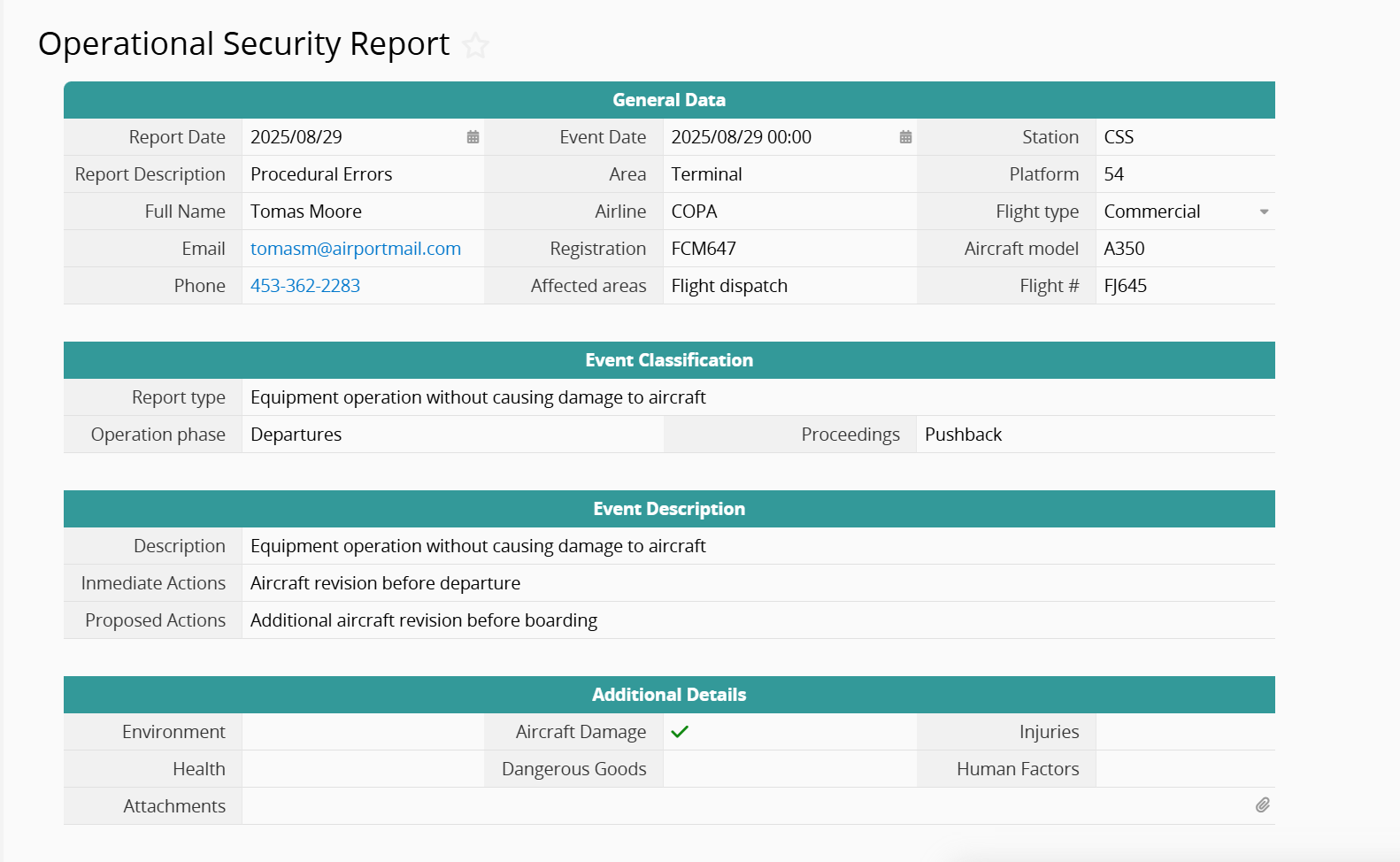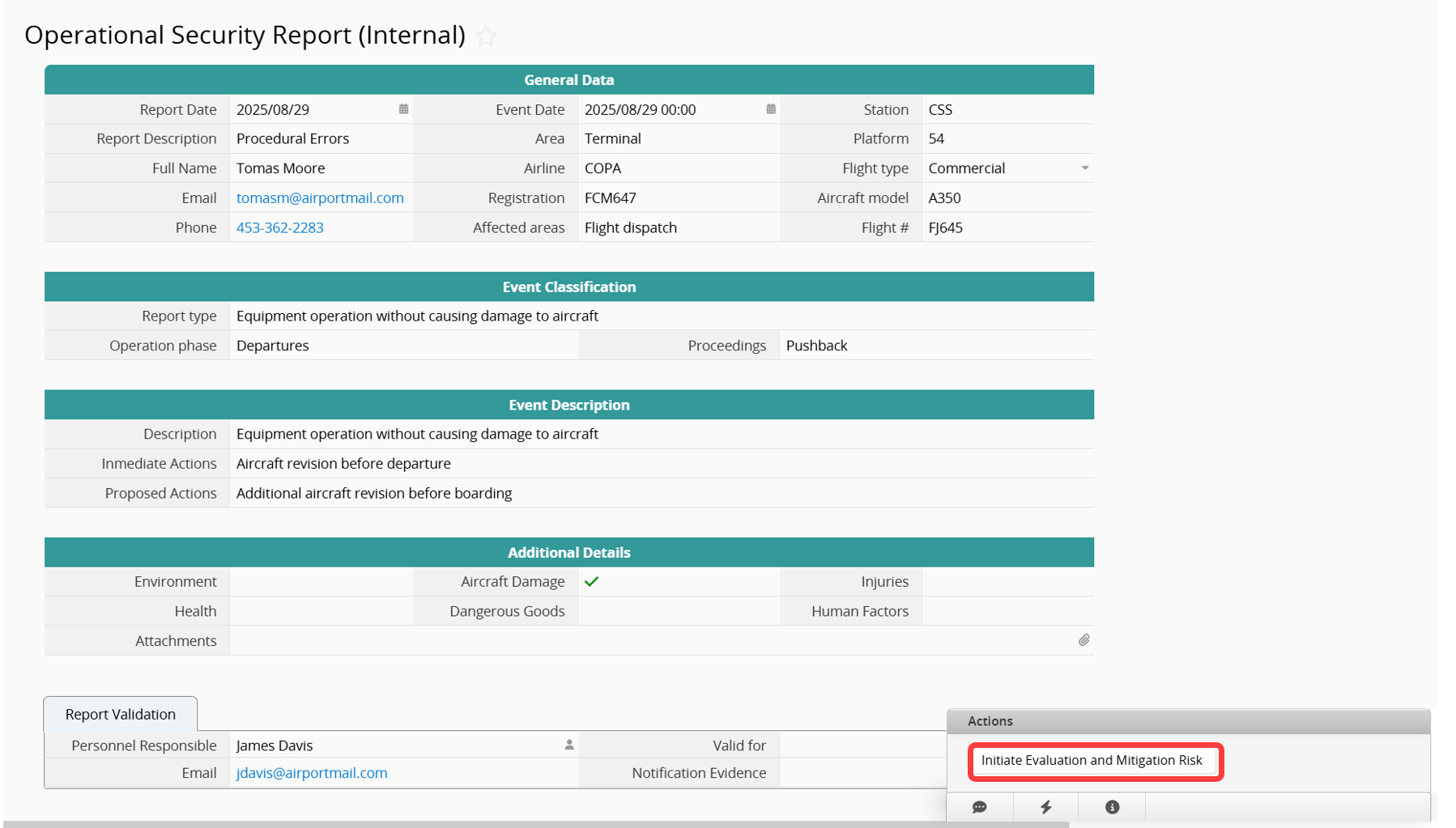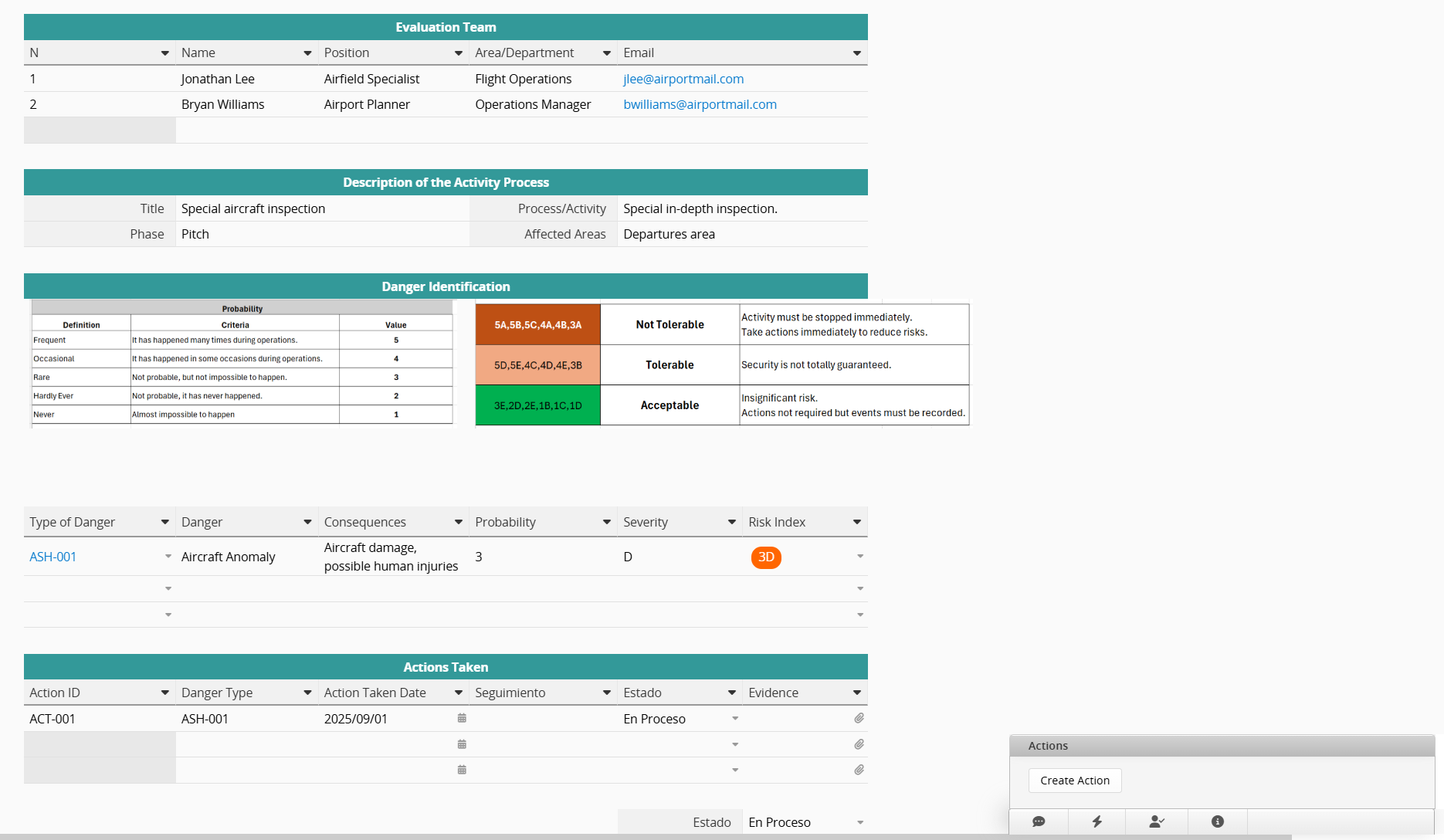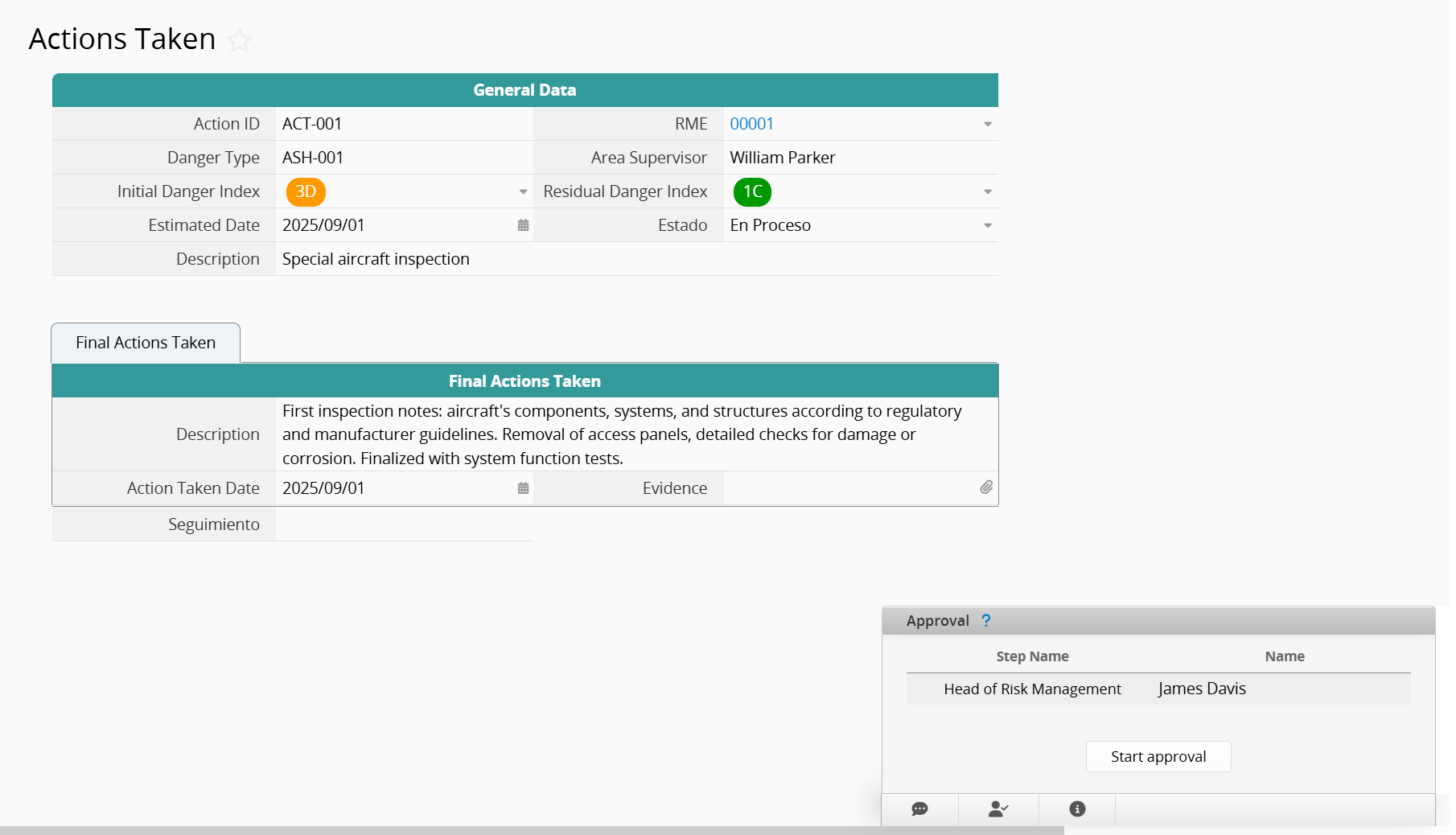From Ramp Paperwork to Real-Time Safety: How Siaca Transformed Airport Risk Operations with Ragic

| Company Name | Siaca Services |
| Industry | Commercial and cargo aviation |
| Benefits of Implementation |
|
| Applications | Custom Risk Management Workflow |
| Subscription Plan | Professional |
| Scale of Use | 11 Internal Users |
Siaca services provides multiple specialized aeronautical services to the world's most important international airlines. Whether it is cargo management, passenger service, aircraft cleaning, or ramp services, the Siaca team plans and executes all necessary activities to ensure all ground operations are successful while providing the highest safety and operational quality at Simón Bolívar airport.
Since airport operations may present safety hazards at any given moment, they have designed a risk management workflow that ensures that even the smallest risk concern gets reported to the corresponding staff and is properly addressed.
Challenges
Before digitizing their workflow, the Siaca risk management team faced multiple challenges, including weather-related issues, complex software, and potential data security concerns.
Challenge: Paper vs the Environment
Imagine you're out in the field investigating a safety hazard when it suddenly starts to rain, or a blast of wind blows your way. In the worst-case scenario, you might find yourself chasing papers down the ramp. With your task interrupted, you might have to return to the office, print a new copy of the report, and head back out to complete your investigation all over again.
Due to its geographic location, the Siaca team often faces rainy weather conditions while they are out on the airport ramp. Accidents or safety concerns may arise suddenly, at any time, anywhere in the airport, and risk reports must be completed on the spot to collect the most data in the most accurate way possible. While paper may be easily managed in an office environment, it definitely presents a challenge for their daily fieldwork given the unpredictable weather conditions.
Challenge: PDF Signature
As they tried to digitize their workflow, they tried a PDF e-signature. This represented different challenges for some users:
Where to share the PDF file? Where to upload? How do I access it? Digital signing process? Is there a new version? It’s not compatible with my device.
While PDF signatures may suffice for a single-user signing process, they may become troublesome if a document requires signatures from multiple users and must be accessed from different devices. Not to mention that this process may also present security risks.
Before adopting Ragic:
“We had a database in Excel. Later, we tried an aviation tool, but it was complex and difficult to interact with. We had a few meetings. But the workflow was so broad it was difficult to take. It was difficult. We wanted to look for an option we can easily work with.”— Ivan Márquez.
Streamlining the Risk Management Process with Ragic
“Currently, the system has a reporting option where the person at their workstation detects something and can write it down, send it to us, and that information reaches us, and we analyze it. Staff can report it in the system for us to monitor, or we can go to the worksite and identify it. Then, the department responsible can take action, we define actions, and then there's a follow-up to finalize or monitor the activities planned to be carried out, to somehow prevent this from happening again.” — Ivan Marquez
Risk Management Workflow
Operational Security Report
Ragic’s mobile version allows users to easily access the database and report any occurrences they may encounter throughout their shift.
Using their smartphones, users can scan a QR code to access the operational security report and fill out the details of occurrences they may notice in their area of work, and submit for revision. This guarantees that even the smallest safety concern is brought to the attention of the risk management team so they can accurately assess each report and take action accordingly.
Each report includes general details such as date, location, description of incidents, department, damage to the aircraft, or injuries reported if the accident has already happened. The users can easily add images to their report by opening their camera from the upload image field in the form.

All report types have already been classified by the risk management team, making it easier for the users to select from the drop-down menus and speed up the narrowing-down process.
“I think the mobile option is an excellent plus for our area, because there are activities that are carried out in the field, directly in the operational area where the aircraft is located. And that's where you can get the most out of it, beyond sitting in front of a computer at a desk."
Operational Security Report (Internal)
The risk management team reviews the report in a more elaborate version of the Operational Security Report Sheet. This is where they can validate the report, assign responsibilities, and notify the corresponding staff.
Using the convert records button, they can convert the risk report into a risk evaluation and mitigation, so the responsible team can start an in-depth risk evaluation.

Evaluation and Risk Mitigation
The risk mitigation sheet includes all risk report details, and it uses a subtable to list the assigned participants who will evaluate and determine the overall impact of the safety concerns or accidents reported.
In a subtable, the team lists all details of the dangers identified, the consequences, severity, current measures, and the actions taken.
Using an action button, they can create records in the “Actions Taken” sheet to add further details to each action and to be approved individually.
All actions are linked to their corresponding ERM. All actions can be viewed with a reference subtable that will automatically update the details of each action required to complete the Evaluation and Risk Mitigation for a risk report.
Each action will be submitted to the Risk Management team for approval.
“The approval flow no longer requires bringing a physical document for someone to sign. Teams aren’t always in the same location, but now they can easily approve in the system. This approval process is more efficient and user-friendly.”

Actions Taken
In this sheet, each "Action" record is linked to an Evaluation and Risk Mitigation ID. It includes the danger details, designated staff, and status as well as the Action process.
The designated staff must upload evidence of the actions taken and indicate whether or not a follow-up is required. After filling out the details, the action must be submitted for approval.
Using the update value button, they can update the action status of each completed action. These changes will automatically reflect in the corresponding Evaluation and Risk Mitigation.

The Results
The Siaca team has smoothly progressed from handling PDF files, printing forms, and gathering teams from different areas to review and inspect operations, to conveniently logging in to Ragic using individual user IDs to add action plans or comments. This makes the team communication more fluid and dynamic.
Processes that previously required manual input of staff's personal information are now easily completed with one click and only require the member's signature. This significantly reduces the amount of time spent on each activity.
Lastly, since the team works from multiple areas, Ragic's mobile version allows them to access their database on the go, boosting their overall team efficiency.
Category: Case Studies > Services



